Urban centers made primarily of sustainable, renewable wood products could be key to mitigating climate change and even function as carbon sinks, and Washington state and its working forests are helping to lead the charge.
Vox recently reported that wood has become “the hottest new thing in sustainable building” and points to Washington state as a forerunner of mass timber adoption in the U.S. Home to numerous working forests and a deep connection to the timber industry, the Vox article notes that it’s no surprise that the Pacific Northwest has become an epicenter of the renewed interest in using wood as a building material and growing enthusiasm for innovative wood products.
“On the supply front, Vaagen Brothers, a well-known Washington sawmill, has already spun off a secondary company focused on CLT; other mills are expected to follow suit, “ Vox reports.
“I’m excited that we have companies in Washington state producing these innovative wood products,” said Rep. Kim Schrier (D-8th Dist.) during a House Agriculture Committee hearing focused on Innovative Wood Products: Promoting rural economies and healthy forests on Feb. 26th.
Mass timber admirers point to the numerous benefits engineered wood products provide, including its resilience in fire and earthquake, capacity to reduce carbon emissions, pleasing aesthetics, economic development potential in rural communities, and ease and efficiency in construction. Supporters also note that engineered wood products can be made with dead and smaller-diameter trees harvested during the thinning process, helping to bolster good forest management practices and reduce the severity of wildfires.
During the hearing (at the 1:28.00 timestamp), a representative from the US Endowment for Forestry & Communities reported to Rep. Schrier and the committee on the collaborative effort between the forestry industry, environmentalists and federal agencies to support forest restoration efforts within the Colville National forest and that such efforts should be replicated throughout the U.S.
Transitioning to more wood-based construction has become a necessity, many builders, urban planners and architects insist. The building and construction industries are responsible for nearly half of all global steel demand, with steel and concrete production identified as massive carbon dioxide emitters. Incorporating more wood products could have a significant impact on efforts to remove greenhouse gases from the atmosphere and adopting more eco-friendly approaches in construction.
The Yale Daily News reports that new joint research conducted by the university’s School of Forestry & Environmental Studies, School of Architecture and Potsdam Institute for Climate Impact Research in Germany found that that “the use of engineered wood in urban construction could help cities absorb excess carbon from the environment” and that “timber products have the potential to turn our buildings into carbon sinks.”
According to the Yale Daily News:
The study’s findings show how wood buildings can function as carbon sinks, where the material removes carbon from the air and stores it, thus helping to offset the excess carbon produced in urban areas. According to Potsdam Institute researcher and co-author Christopher Reyer, since the world’s population is increasing, climate change mitigation efforts will be challenged by people’s need for shelter.
“For cities and urban areas, we already know that climate-friendly building will be important,” Reyer said. “If the buildings can be an additional carbon sink, they are part of a bunch of larger-scale solutions that [reduce] emissions.”
The Yale University article goes on to report that:
The researchers forecasted how a switch from traditional building materials, such as steel and concrete, to engineered wood would reduce the global emissions produced during the manufacturing process as well as the carbon storage potential of each. Depending on the level of commitment to this building approach, cities could increase their carbon storage by 25 to 170 percent, it said, which will help climate change mitigation by 2050.
